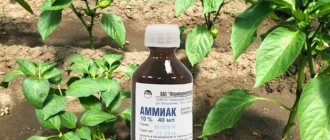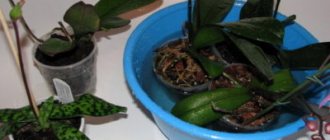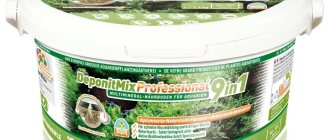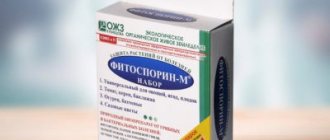Anyone who grows violets sometimes faces problems related to the health of the flower. In this case he you need to come to the rescue as soon as possible.
The modern market is saturated with various chemical plant protection products, but preparations of natural origin are especially popular among flower growers. These include Fitosporin , which is successfully used both for the treatment and prevention of microbial diseases in plants. This article provides a description, instructions for use and reviews of this drug.
Description of the drug
Active ingredient of the drug: Bacillus subtilis 26 D, 100 million cells/g. Produced in UFA.
The drug belongs to the class of bacterial fungicides and biological pesticides. The impact begins from the moment of application.
According to the hazard class for human exposure, the drug belongs to class 4. In case of close contact with the substance, it may cause irritation of the mucous membrane.
According to the hazard class for impact on bees, the drug belongs to class 3. Safe distance is 4-5 kilometers. Fitosporin does not pose a threat to beneficial insects.
The drug is released in the form:
- Powder in bags of 10 or 30 g. The titer must be at least 2 billion spores and living cells and spores/g;
- Pastes in the form of a flat cake in a bag weighing 200 grams. The titer must be at least 100 million living cells and spores/g;
- Liquid suspension. The titer must be at least 1 billion living cells and spores/ml.
Advice from experienced violet growers
Violet loves a light, breathable, nutrient-poor substrate. Over time, the acidity of the soil in the container under the flower changes. Its optimum for violets should be in the range of 6.0-6.5. You can increase acidity using peat, and lower it by mixing soil with dolomite flour.
Violets prefer neutral soils.
Too nutritious soil encourages root growth rather than leaf growth. To make the soil loose and light, add balls of polystyrene foam, fine perlite, vermiculite or dried sphagnum moss. The soil in the mixture should be no more than 1/3 of the volume of the cup.
You can tell whether the soil is wet or dry by the weight of the pot - hold it in your hand before and after watering to feel the difference.
Use of phytosporin
The drug refers to drugs that can independently spread throughout the plant’s vascular system. The basis of Fitosporin-M is a spore culture, which, thanks to its waste products, can suppress the development of fungal and bacterial diseases:
- Alternaria;
- Bacteriosis;
- Root rot;
- Powdery mildew;
- Brown rust;
- Fomosa;
- Rust;
- Snow mold;
- Bacterial spotting;
- Septoria;
- Monolial burn;
- Downy mildew;
- Rhizoctoniosis;
- Fusarium rot;
- Cercospora.
The drug also protects against the formation of rot during storage:
- Gray rot;
- Black dry rot;
- White rot;
- Fruit rot.
It is important to understand that such a drug cannot cure or prevent absolutely all diseases. Its effectiveness may vary from plant to plant. It depends on the type of disease, the effect of the drug can be from 65 to 95%. Such indicators are considered good, given the fact that the drug is low-toxic and can be used at home.
One of the advantages of the drug is that live cultures can be stored at temperatures ranging from -50 to +40°C. Even in freezing conditions, the drug retains its properties. If unfavorable conditions are created for the Bacillus subtilis culture, it goes into a spore state and vital activity ceases for a while. However, as soon as conditions are restored, the bacteria become active again and inhibit bacteria and pathogenic fungi. In addition, the biofungicide Fitosporin-M may contain the bioactive fertilizer GUMI. As a rule, the manufacturer writes about this on the packaging. Humic acids are used to treat the root system. You should not treat vegetables and fruits with them, even before storing.
Important !!! The main advantage of the drug is the ability to use it at any period of plant development. It can be used both during the growing season and during the period of flowering and ripening of fruits.
The manufacturer claims that the crop is safe even on the day of treatment with phytosporin.
However, it is worth highlighting the disadvantage. When exposed to direct sunlight, Bacillus subtilis bacteria die, so spraying of plants should be done in cloudy weather or when the sun is not active. In addition, we must not forget to rinse fruits and vegetables with hot water before consuming them. Simply wash the berries under cold running water.
The drug can also be used to treat seeds and seedlings before planting. Experienced gardeners often treat open ground with phytosporin. Any weather conditions are suitable for this procedure. But there is one caveat: if it rains after spraying, then re-treatment will be necessary, as the protective film will be washed off. The frequency of spraying should be 1-2 weeks. If the rains are too frequent, then you need to spray a couple of hours before the rain or immediately after the rain.
If Fitosporin is used for irrigation, then the frequency of the procedure for vegetable crops is 1 time per month, and for fruits and berries - 2 times. If we are talking about indoor plants - once a month.
To combat scab, you can also treat trees with phytosporin. To do this, you need to dissolve 5 grams of powder in 10 liters of water. Spray the tree crown using a stepladder or ladder. It is recommended to combine spraying with phytosporin with a growth stimulator. For example, zircon (1 ml of substance per 10 liters of water). The first spraying should be done when the leaves are at the unfolding stage, and the second - when the ovary process has just begun. Watering the trees is not necessary, since a large amount of solution will not be absorbed by the roots.
Phytosporin powder
You need to prepare the solution 1-2 hours before spraying:
- Soaking bulbs and tubers. You will need: 10 grams of powder, 500 ml of water. Treat preplanting material with this solution;
- To soak the seeds before sowing. You will need: 0.5 teaspoon of powder and 100 ml of water;
- To prevent rot in the root system of seedlings. You will need: 10 grams of the drug and 5 liters of water. You need to leave the roots in this solution for a couple of hours. After and before planting, you can water the soil with the solution;
For preventive purposes of bacterial and fungal diseases:
- For potato prevention: 10 grams of powder per 5 liters of water. Repeated spraying after two weeks;
- To prevent cabbage: 6 grams of powder per 10 liters of water. Repeated spraying after 2-3 weeks;
- For the prevention of tomatoes, eggplants and peppers: 5 grams of powder per 10 liters of water. Repeated spraying after 10-14 days;
- For the prevention of cucumbers: 10 grams of powder per 5 liters of water. Treat three times at intervals of 10-15 days. For treating garden flowers and indoor plants: 0.5 teaspoon per 2 liters of water - for preventive purposes. For treatment purposes - 0.5 teaspoon of powder per 1 liter of water;
- For treating the soil before planting berries and vegetables: 5 grams of powder per 10 liters of water. Treat the soil a week before planting.
Fitosporin paste
Fitosporin-M paste, which contains GUMI and does not require additives. How to prepare the solution: add 100 grams of paste to 200 ml of water. The solution can be stored for a long time. Before spraying, the mixture must be diluted with water:
- Before planting or storing tubers and bulbs, you need to dilute the solution: 3 tbsp per glass of water. spoons of concentrated mixture;
- To soak vegetable and garden flower seeds, add 2 drops of solution to 0.5 cups of water. Keep the seeds in the solution for 2 hours;
- To strengthen the cuttings you need to take 4 drops of concentrate per 200 ml of water;
- Foliar spraying of berries, vegetables, fruits and flowers for preventive purposes - 3 teaspoons of watering mixture per 10 liters of water. And for spraying - 4 drops of the mixture per 200 ml of water;
- Spraying indoor plants. For 10 liters of water you need to take 10 drops for spraying. And for irrigation, 15 drops per 1 liter of water.
Fitosporin liquid
Liquid phytosporin in finished form is used to treat vegetative crops:
- Indoor;
- Fruit;
- Vegetables;
- Berry.
And also for spraying tubers before storage.
The manufacturer offers to use the solution in various variations. The bottle may contain the following inscriptions:
- "Fitosporin - M Bioprotection for flowers and indoor plants";
- "Fitosporin - M Golden Autumn";
- "Fitosporin - M Storage."
All solutions have an identical composition of useful substances.
Fitosporin-M Reanimator
Bacillus subtilis concentrate contains many amino acids and other useful microelements. All useful substances help dissolve the cell walls of fungi and bacteria. In addition, the drug helps restore plant growth after:
- Overmoistening;
- Sunburn;
- Disease damage;
- Freezing.
The solution can be used with other stimulants for the growth of seedlings.
Watch the video! How to save sick plants Fitosporin M Reanimator
Common diseases of violets
Improper care of Saintpaulias leads to various problems associated with the appearance of flowers. A decrease in temperature, high air humidity, and waterlogging of the soil contribute to the rapid development of spores of various fungi. Diseases can be infectious or non-infectious.
Root rot
With excessive watering, the Uzambara violet loses its attractive appearance, the leaves droop and become dull. The root system dies. The roots change color to brown and become soft. The plant is exposed to putrefactive fungi.
To cure violet, urgent measures are needed. To do this, it is important to wash the roots from the previous soil and remove damaged ones. Before transplanting, immerse the remaining healthy parts in a solution of the drug Fitosporin. For a new planting, it is better to use a different soil and pot. If you use an old florist, it must be carefully processed: washed and disinfected, calcined or steamed in the oven, treated with a solution of copper sulfate. On a diseased plant, you can select the upper healthy leaves and root them, after pre-treating them with fungicides to prevent the disease.
Stem rot
Saintpaulia may suffer from careless propagation. In this case, the stems may also rot. The causes of the disease are:
- unwashed and unsanitized instruments;
- deep wounds that were not allowed to heal;
- sections not treated with antifungal agents during propagation;
- excessive watering of young plantings, after which the young roots did not absorb moisture;
- a young, fragile plant was attacked by pests.
The proliferation of putrefactive bacteria on weakened flowers progresses noticeably. Such Saintpaulias can rarely be saved.
Brown rot
The brown base of young rosettes, rooted cuttings and planted children, which becomes thinner over time and softens the stems, indicates infection of Saintpaulia with spores that cause brown rot. There are traces of mycelium on the soil under the leaves.
The disease can spread to other plants, so urgent measures should be taken:
- treat leaves, stems and shoots with antifungal fungicides (Skor, Fundazol);
- apply shallow rooting;
- treat the soil with Fitosporin, PhytoDoctor or Trichodermin;
- use soil that is loose in structure and has good water permeability for planting;
- use frequent but small watering of plants.
Gray mold (botrytis)
The disease is accompanied by the appearance of a gray fluffy coating on the surface of the leaves, the stems soften and weaken. Over time, all parts of the plant turn white and rot. The disease develops from spores in the planting soil, as well as when using old, undisinfected soil, where there may be remnants of previous diseased plants.
To preserve Saintpaulia, you should immediately remove parts of the plant that have wilted.
Further treatment:
- soil disinfection using calcination, freezing, and fungicide treatment;
- treatment of Saintpaulia with fungicides to prevent the spread of the disease.
Prevention:
- spray in the warm season;
- maintain optimal air humidity and regular ventilation;
- eliminate temperature changes;
- control watering of plants, avoiding stagnation, do not get water on the leaves when watering;
- do not place flower pots close to each other;
- prevent the formation of vapors on the walls of the container during reproduction.
Leaf rust
A characteristic coating appears on the bottom of the leaves of the Uzambara violet in the form of yellow or brown thickenings and bulges; it rarely appears on the petioles; on the upper side there are light yellow spots. Over time, fungal spores, spread by air, mature on the lower part of the leaf.
At optimal ambient temperature and humidity, spores do not germinate. To eliminate violet rust disease, it is necessary to adjust environmental indicators.
Powdery mildew
Uzambara violets are susceptible to powdery mildew, which comes in two types: false and true. To specify the diagnosis, it is worth paying attention to the nature of the spots. Downy mildew is accompanied by brown stains. A sign of a real one is the whitish shades of the lesion on the stem and leaves of Saintpaulia. Infection could occur when previously used soil was consumed without treatment or with newly acquired plants.
For sick violets, the following measures are recommended:
- adjust environmental humidity;
- increase the room temperature;
- bring the lighting back to normal by creating additional lighting;
- regularly remove dust on leaves and pots;
- carry out additional fertilizing with phosphorus-potassium fertilizers, since excess nitrogen can also lead to plant damage.
Late blight
Drooping of flowers, accompanied by separation of roots, is caused by late blight. The leaves begin to curl. Cool temperatures and high humidity with insufficient lighting contribute to the disease. In order to fight the disease, the violet needs to create the appropriate conditions:
- remove damaged plant parts and roots;
- replant into new disinfected soil with the addition of perlite, which helps maintain soil moisture;
- treat the violet and soil with Fitosporin or similar preparations;
- root unaffected upper leaves to grow a new flower;
- maintain optimal air temperature and humidity for the newly transplanted plant, and increase illumination.
Fusarium
Brown, falling leaves of violets indicate damage to another fungal disease. As a rule, spores enter the plant from the soil through the roots. The toxic substances released spread to all parts: stems, leaves, flowers. They turn brown and rot. Caused by cold temperatures with increased watering. Sharp temperature changes and heavy planting soil contribute to the intensification of the disease.
Treatment is as follows:
- remove all damaged parts;
- treat the remaining parts of the plant and soil with Fitosporin or Fundazol;
- replant into disinfected soil;
- reduce watering the plant;
- increase the room temperature;
- ventilate regularly.
Vascular bacteriosis
Affected plants have wilted, weak leaves. The disease begins from the affected soil. Fungal spores settle on the roots. As they grow, they release toxic substances that penetrate the plant tissue and destroy it completely. Appears at elevated temperature conditions.
The hotter it is on the windowsill, the faster the disease develops. It is almost impossible to save the plant.
The disease is not transmitted to neighboring violets; they can be saved by creating normal living conditions. Another condition for the progression of bacteriosis is increased soil moisture under cool environmental conditions in winter.
Prevention measures:
- adjust temperature and humidity conditions for keeping flowers;
- increase additional ventilation without direct contact with flowers;
- pre-disinfect the soil and free it from the remains of previous plants;
- use soil with good conductivity for planting, additionally loosening it with vermiculite;
- exclude fertilizing during the recovery period;
- additionally treat the plants with drugs that increase immunity.
Leaf spot or bronzing virus
When Uzambara violets are exposed to direct sunlight, the plant suffers from bronzed leaves. Another condition for the occurrence of the disease is the ingress of water drops during irrigation. The disease spreads with poplar fluff through thrips. A diseased plant stops developing. The leaves become covered with a distinctive coating of red or brown spots. The virus cannot be cured.
Control measures:
- replace soil that may contain fungal spores;
- exclude bright sunlight by moving the flowers to a warm place with diffused light;
- reduce quantitative watering;
- When watering, monitor the direction of the water stream.
The use of phytosporin during fruit ripening
Any plant can be treated with phytosporin, both during flowering and fruiting. For example:
- Cucumbers;
- Grape;
- Tomatoes;
- Strawberries;
- Raspberry.
After processing the plants, the berries can be eaten immediately.
It has been proven that Bacillus subtilis bacteria are not dangerous to animals and humans. Confirmation of this is the assignment of GRAS (safe organisms) status to the drug. In addition, some strains of Bacillus subtilis are included in medicinal products. One of which is Biosporin. The drug is widely used to treat intestinal infections. Thus, phytosporin can rightfully be considered a safe drug.
"Universal"
Let's look at the instructions for using Fitosporin. In gardening stores, the powder form most often offered for use is suitable for any plant.
“Universal” can be used for preventive treatment and therapy:
- scab;
- late blight;
- rot;
- powdery mildew;
- black leg, etc.
Important! In 1 tsp. powder contains 3 grams.
Cooking features:
- Settled water is used;
- The protective composition is prepared 1-2 hours before treatment. It is recommended to dilute the powder 1 day before the procedure to obtain more bacteria;
- The liquid can have a temperature of +15…+35°C.
Fitosporin for tomatoes and cucumbers
The drug is used to treat tomatoes and cucumbers. It is important to understand that such crops require intensive care, as they are susceptible to many diseases, so it would be a shame to lose the harvest.
It is unacceptable to treat cucumbers and tomatoes with the drug at the time of flowering, since pesticides tend to accumulate in the fruits. But there is a way out - at the time of flowering, apply foliar fertilizers, for example, boric acid.
Important! Don't forget about late blight prevention.
Protection of seedlings from late blight and other diseases is carried out at different periods:
- When soaking seeds;
- When planting seedlings.
It is worth remembering that in a greenhouse or greenhouse the microclimate is favorable for the development of infections. It is enough to treat with fungicides 1-2 times per season.
As for phytosporin-M, the soil can be treated with it many times, since it is an indispensable tool for organic farming. Despite the fact that the drug has a weak antifungal effect.
Tomatoes and cucumbers should be sprayed with a solution at the rate of 5 grams of phytosporin-M per 10 liters of water. After 5-7 days it is necessary to spray again.
Concentration doesn't matter. You can add enough phytosporin to get a rich tea color.
Important! You cannot process tomatoes and cucumbers outdoors in cold weather! Watering frequency is at least once every 5 days.
Insect pests of violets
In addition to diseases, violets suffer from a number of pests.
Mealybugs
Mealybugs are round insects with a white or waxy coating that reproduce very quickly in favorable conditions. They feed on plant sap, completely weakening the flowers.
Signs of damage include the appearance of a mushroom smell from the soil, a change in green color to yellow or gray, a decrease in the elasticity of the leaves, stunted growth and the appearance of rotting of roots and leaves.
Control measures: treating flowers with insecticides.
Ticks
Violets infect two types of mites: cyclamen and spider mites. The former damage young leaves and stems, leaving yellow marks. The latter make red punctures on the leaves, on which a web is formed. Ticks are carriers of many diseases, so it is necessary to take measures to destroy them. Insecticides are used to control pests.
Aphid
A small transparent greenish insect brings a lot of trouble to Saintpaulias. It affects all succulent parts, sucking juice from leaves, petioles, and buds. Toxic elements are carried by juices throughout the plant, slowing down development and deforming it.
To combat aphids, flowers are treated in the shower, washed with soapy water, and in difficult cases, sprayed with insecticides.
Nematodes
Signs of violet infection by nematodes are dark green spots that gradually darken and rot. The growing point dries out, from which deformed leaves develop. The condition of the flowers is weakened, drooping, flower stalks with buds do not appear, the stems are bent, and ultimately the plant dies. The pest can only be identified by looking at the soil. To do this, remove the violet from the pot and examine the condition of the roots.
The nematode is a tiny insect that is very difficult to remove.
Control measures:
- complete replacement of soil with disinfected one;
- treating violets with insecticides if the infection has just begun. Otherwise, the plant is destroyed.
Garden violets (pansies) also suffer from putrefactive diseases. She suffers from powdery mildew, rust and viruses less often. Of the pests, in addition to those listed, it is attacked by slugs.
Compatibility of Fitosporin
The drug is well compatible with other chemical pesticides:
- With insecticides;
- With fungicides;
- With fertilizers and growth regulators;
- With antibiotic drugs - Fitolavin.
Advice! It is unacceptable to combine with drugs with an alkaline reaction!
In addition, manufacturers produce a special preparation for specific vegetable crops:
- “Fitosporin-M cucumber;
- “Fitosporin-M tomatoes.
Each preparation contains special microelements that are necessary for a specific crop.
Therefore, the preparations cannot be used to treat other vegetable crops. Fitosporin-M is universal and should not be combined with other fertilizers to avoid an excess of minerals.
Security measures
You need to handle plants while wearing gloves. Do not smoke or eat while gardening. If suddenly the solution gets on the skin or mucous membranes, then it is necessary to rinse the affected area with water. If the concentrate enters the digestive system, you should drink 4 glasses of water and induce vomiting. Afterwards take activated carbon.
The drug should be stored away from medications and food. Make sure that the concentrate does not fall into the hands of children. The shelf life of the drug is 4 years. The solution is stored at moderate temperatures.
Resuscitating ambulance
Phytosporin "ReanimatoR" is a quick therapeutic aid. The drug is effective if preventive treatment has not been carried out, and fungi or bacteria have infected the plants. The fungicide is sold in 200 ml containers.
What diseases is Reanimator effective against?
- Black leg;
- Powdery mildew;
- Scab;
- Gray rot;
- Late blight;
- Bacteriosis;
- Rust.
The drug Fitosporin “ReanimatoR” is effective when the initial stages of the disease have been missed, and now the plants are going through difficult “times”: the foliage is dying, increasing spots and mold are visible, roots and stems are rotting, and buds are falling off.
The concentrate of the liquid drug depends on the severity of the lesion:
- If the lesion is of moderate severity, dilute in a ratio of 1:20 (in 2 liters - 100 ml);
- When the damage is of a high degree, you need to dilute 100 ml of “Reanimator” per 200 ml of liquid;
- Treat the vegetation 2-3 times every 2 days.
TOP 10 most popular varieties for beginners
When choosing a green beauty, you need to be guided not only by external data, but also by your own ability to provide the conditions.
Having studied the opinions of experienced collectors, we bring to your attention the most unpretentious varieties of violets for beginners , which do not require particularly close attention.
"Arctic Frost"
It grows in almost any conditions ; neither bright sun nor shade hinders it. Feels good on any window. Tolerates different levels of humidity.
But if you want to admire the blooms longer, it is better not to leave them for a long time under the scorching rays of the sun.
"EK-Nautilus"
Author: Elena Korshunova. Easy to grow.
White-blue semi-double flowers with blue stripes from the middle and waviness of the petals will win the heart of even a sophisticated connoisseur.
The rosette is small, medium green, flat.
Hot Spot
Lovers of red flowers will like it. Abundant flowering and corrugated edges of the petals will not leave anyone indifferent. Leaves are bright green.
One of the fastest growing varieties.
"Balchug flight"
Chimera with a small neat rosette and strong peduncles bearing up to 7 flowers. Sometimes such a bouquet obscures the rosette with its size.
Quite stable. It forms many stepsons from the stem, which simplifies reproduction.
Fast growth, early and luxurious flowering in minimally comfortable conditions allows us to recommend this variety to beginning gardeners. And if you organize lighting 12 hours a day , the flowering will become more abundant and longer.
"Morenkönig"
It surprises with the color of the petals - they are like black velvet . You won’t be able to forget what you saw, this plant is so impressive.
It can grow both indoors and outdoors , this is facilitated by its cold resistance and unpretentiousness.
Favorite Daughter
Author: Boris Makuni. A large rosette of wavy soft lilac flowers blooms earlier than others.
And the bush itself develops quickly even with standard care and will not cause trouble to its owner.
LE-Peach Shine
The rich peach shade in the center of the flower and the densely corrugated edge, reminiscent of lace, attract attention
The leaves are collected in a dark compact rosette.
"Adonis"
It became popular back in the nineteenth century in France . It differs from other Saintpaulias in having a yellowish center against a background of blue petals with a dark blue spot.
The bush is about 25 cm in height, with light green foliage. Feels great both on the windowsill and in the flower bed.
It will delight others with its luxurious blooms already in April and will not disappoint until late autumn.
Abendglut
Despite the average size of the bush, it has large – 6 cm flowers of a cherry hue with brownish inclusions . And there can be up to two dozen of them at the same time!
Flowering is possible twice with a short break:
- April-August;
- September October.
Violet overwinters without problems and is undemanding to conditions.
Mas Glass Sleep
The crystal slipper is easy to maintain and is suitable for starting a collection.
The combination of light green leaves with a light border and snow-white flowers with a bluish border gives an elegant look. And the ruffled edge is reminiscent of ruffles on a fashionista’s dress.
This species is valued for its year-round flowering and even rosette , which will not be spoiled even by a lack of light.
Other
If the varieties listed do not catch your attention, consider the following options. According to some gardeners, non-capricious varieties include:
- Pink Amiss;
- Frosty Frolic;
- Warm Sunshine;
- Golden Autumn (Sorano);
- Vinces Choice;
- Suncoast Circus Candy White sports;
- Raspberry Crisp;
- Fire Moths;
- LE-Macho;
- Halo's Aglitte;
- LE-Rings of Saturn;
- AB-Caramels;
- Balchug Avenir;
- Spring Rose;
- Mac's Southern Springtime;
- Blue watercolor.
Question answer
How to water the soil when digging and process the compost?
To prepare a bio-fungicide that will disinfect the soil when digging, you will need to dissolve 15 ml of paste concentrate in 10 liters of water. This amount can treat 2 m2 of area. To speed up the process of ripening the compost mass, add 15 ml of paste to 1 liter of liquid, mix, let it brew according to the instructions and process 40 kg of compost.
Is it possible to mix the fungicide with other protective drugs?
The manufacturer claims that the drug is compatible with organics and mineral complexes. How to properly dilute Fitosporin with other plant protection? Each product must be diluted only according to the manufacturer's instructions. It is better not to combine bio-fungicides together. Otherwise, a situation will arise where bacterial spores alone will suppress competitors. As a result, the effect of the treatment will be minimal.
How long can the diluted drug be stored?
Bio-fungicide of any release form is stored for 4 years from the date of production. The powder is stored at +20-30 °C, in the liquid state - at +5...+25 °C.
Trichodermin or Fitosporin: which is better to choose?
Both biological products protect plants. But you can't mix them. If used, then, for example, treat the above-ground parts of plants with Fitosporin, and treat the soil with Trichodermin. Or alternate fungicides every 15-20 days.
What analogues exist or what can replace them?
There is a replacement: Alirin-B and Gamair.
Will Fitosporin-M help against powdery mildew?
Yes, it will help cope with different degrees of damage, but it is best to use it for prevention.
Larisa Nikolaevna Shirko
A gardener with extensive experience ready to answer the most difficult questions
Ask a Question
Now you know that this bio-fungicide is a protector and assistant when growing any type of plant. Its main advantage is the possibility of application at any period and at any stage of the plant growing season - during growth, flowering, fruiting.
If you are not sure how to properly dilute the product, then follow the instructions for use of Fitosporin-M. In most cases, on the packaging the manufacturer indicates the dose, rate of application and frequency of treatment or prevention.











